#with roots in ancient history
Explore tagged Tumblr posts
Text
me, someone who has been exposed to zionism and Israeli culture/history since elementary school and has done quite a bit of research into both topics as a result: zionism and i/p are a lot more complicated than that
some rando who only talks about i/p conflict when the violence escalates and has no understanding of what zionism is: it's really simple actually zionism is evil
#like I'm sorry what#we're talking about a umbrella term#for an ideology#that has it's own left and right wing#and existed before it became political#and a conflict#with roots in ancient history#where the important#context#is at least 100 years#that is affected by#western powers#and antisemitism/islamaphobia in general#where both grups involved#can make the claims of#indigenity#and religous holy land#and where the history includes#so much terrorism#like a crazy amount of terrorism#and then the UN#fucking shit up#not even to mention#the huge information war#that has been a part of it#since day one#it's pretty complicated#like it's really fucking complicated
6 notes
·
View notes
Text
There is no ancient "Palestine "
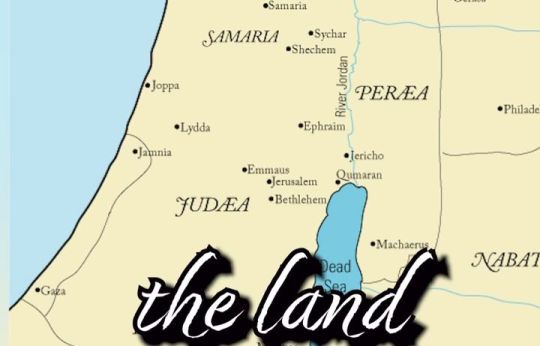
I love watching Deborah's videos because she actually presents facts and brings the receipts .
🇮🇱🫶
#israel#gaza#palestine#there is no ancient land called Palestine#jewish roots#jewish history#pro israel#i support israel#🇮🇱🫂💙🫶
34 notes
·
View notes
Text




#Ancient Africa#African kingdoms#modern design#African aesthetics#digital art#cultural heritage#African royalty#historical art#Afro-futurism#Nubian art#Kushite legacy#Mali Empire#Great Zimbabwe#Benin Kingdom#Ethiopian Empire#Kemet#African history#Black excellence#African symbolism#minimalist design#bold colors#geometric patterns#Afrocentric art#ancient wisdom#African mythology#visual storytelling#ancestral roots#African innovation#traditional meets modern#pan-Africanism
20 notes
·
View notes
Note
Do psychotropic drugs and/or ritual play a role in any of the blightseed cultures? A pretty broad question, lol
Yeah that’s a very broad question, the answer is about as much as it tends to play roles in real history. Alcohol is pretty ubiquitous (outside of cultures that abstain from intoxicants) and used for a variety of purposes, opioids are commonly used in some parts for pain relief or recreational purposes, stimulants (usually in mild, natural forms) are used to provide extra energy, and hallucinogens are most commonly used as part of a larger religious framework (rather than for recreational purposes). Any more elaborate answer kinda has to be case by case in a certain culture or part of the setting.
I'll just take this as an opportunity to talk about the one established sect that pretty much REVOLVES around psychoactive use. This is the Scholarly Order of the Root, which is a sort of mystery religion + elite community of scholars who currently occupy the Ur-Tree and its forest in the far southern Lowlands (southeast of Imperial Wardin, on the same land mass).
The Ur-Tree is the obligatory Huge Fucking Fantasy Tree (and its surrounding forest). It’s a mass of vegetation about a mile tall and almost as old as Plant Life Itself, its upper branches are primeval plants, which become more modern the nearer they get to the ground (and each 'level' holds tiny ecosystems, some containing descendants of LONG-extinct arthropods/other small animals). Its lowest branches and the surrounding forest are contemporary plant life, and all is connected and protected by an incomparably MASSIVE fungal mycelium network (which is itself a living god).
A lot of the Scholars' more secretive practices revolve around experimentation with substance use with the goal of expanding the Mind and transcending the body to fully connect to the Dreamlands, and they have a supply chain of traders and mercenaries called Rootrunners who traffic substances into the Lowlands. Most of their psychoactive use is in a very intentional capacity and not just like, for fun, but a LOT of them are just straight up addicted to cocaine (in the form of alchemically refined bruljenum, which is used for practical purposes of its stimulant effect during long hours of work).
All known psychoactives are desirable for experimentation (particularly hallucinogens), with each having properties that either allow expansion of the Mind, transcendence of the body, or outright divine communion. Their effects are logged in great detail and interpreted to form the basis of the Scholars' understanding of the natural world and reality itself.
The most important substance is Ur-Root, which is root matter from subterranean levels of the Ur-Tree that have both their own intrinsic psychoactive substances and a very, very high concentration of living god mycelium. The tree root contains DMT and the mycelium has its own wholly unique effects (being an actual living god). They alchemically refine it into a purer, more potent form, and use it to expand beyond the body and directly commune with the Giants, a group of entities they have identified as the only true gods.
An Ur-Root trip starts off with minor visual distortion, which turns into shifting fractals that slowly obscure the vision. Eventually the senses are entirely taken over by a 'tunnel' of rapidly shifting fractals and geometries. In a complete trip, the experiencer gets a sense that they have been pushed through a membrane and entered another realm, finding themselves in a distinct experiential Space.
At this point they may encounter entities which communicate to them in a language impossible to describe but wholly understood. These beings are understood to be the Giants, or at least aspects of the Giants that mortals are capable of comprehending (they often take familiar tutelary forms of the Mantis or the Snake, or appear resembling the same type of sophont that the experiencer is, all composed of ever-shifting geometries). The experiencer often feels a sense of unconditional and endless love from these beings, though the Giants may be more hostile and may appear in the form of the Trickster (usually a cultural figure regarded as malicious, be it an animal or otherwise) in a bad trip.
(^Up until this point, this has mostly just been a DMT 'breakthrough' experience ft. 'machine elves' and the like).
They are then removed from this space and returned to something that feels like the real world, but is nearly unrecognizable. They have a sense of rapidly moving through time, and will usually see 'the spires' towards the beginning, which just so happen to look like this:

(source + some context via Implication- the spires are exactly what this art is depicting)
The experiencer continues to move across an unfathomable amount of time, occasionally 'seeing' other such flashes of unfamiliar landscapes and creatures, and yet also being devoid of all their senses, the 'seeing' is pure, unfiltered experience. There is a sense of interconnectedness with all life, and that one has become the forest (or even Life) itself. The sense of time is wildly distorted, the trip lasts only about 5 minutes but feels like an eternity and is understood as literal hundreds of millions of years.
The experiencer has usually lost any remaining sense of Self and individual consciousness during this phase (in which case this time distortion is usually a neutral or even peaceful experience), but some retain a fraction of their identity, and find themselves trapped and conscious while experiencing what feels like eternity (which can be LIFE-CHANGINGLY distressing, even after the fact).
(^This latter part of the trip is the effects of the Ur-Tree fungus).
The trip ends with a sense of rushing through the ground and back up into one's body, at which point they will abruptly return to their senses and consciousness. The details are then immediately retrieved via interview and recorded in immense detail. The whole experience is understood as having been full comprehension of the Dreamlands, communion with the Giants, and then a tour through the act of creation.
This is done as part of the initiatory practice into the inner mystery-religion of the scholars, and as needed for study by high scholar-priests. It is not taken lightly, both as it is absolute communion with the gods and reality, and in that it can be a very, very difficult experience. People who have gone through this often walk away with a permanently shifted perspective, often in a positive and/or comforting way- a sense of interconnectedness with all life, a peace with the concept of death, seeing less of a point in individual ego and the concept of Self, and comfort in the sense of divine love they (may have) experienced. This heavily influences the philosophy of the Scholars and has had effects by proxy in the religious worldviews of the region.
Details of this experience are closely guarded, and initiates are given absolutely no prior knowledge and expectations for their trip. This is seen as a necessity- their naivety will allow for a true, unfiltered experience, and can be used to gauge whether they should or should not be accepted. Those that have a distinctly bad trip upon initiation may be assumed to have been 'rejected' by the giants and thus denied full priesthood, though this largely depends on How they interpret their distressing trip- those who identify this as a test and harsh lesson in a journey to enlightenment may be accepted (as this is how fully initiated scholar-priests interpret and handle their bad trips).
This inner priesthood is only a small fraction of the Scholarly Order, and its greater function is as a hub of education and repository of knowledge, and Scholar-trained doctors can provide some of the best medical care available in the setting ('best medical care in this setting' only means so much but it's pretty solid, relatively speaking). Only a chosen few Scholars ever get to commune with the Ur-Root, and most of the divine secrets revealed in the process are kept hidden (though they indirectly influence the politics and worldview of the entire order).
#I'm kind of fascinated by the quasi-religious beliefs that have developed around recreational hallucinogen use (ESPECIALLY DMT)#In contrast to like. Uses of DMT-containing substances like ayahuasca for long-established religious purposes#So this concept is basically 'what if a religion was FORMED from pretty much the ground up out of DMT usage'#Like the common 'entities' people encounter in recreational use being identified as the Real Gods and producing a religious worldview#that is mostly rooted in this experience (while still influenced by other cultural factors)#Also the like. Meta going on here is that the fungus is a 'living god' and the oldest one on the planet#It is a VERY rare type of living god that is 'created' by non-sophont (non-sentient even) beings and exists as a mycelial network#that perfectly supports and protects an entire forest. Basically a god for plants. It is so deeply interconnected with its forest that the#usual power sophont belief would have over it has basically zero influence. This is absolutely the closest thing to A God in canon.#(While still not being a Creator/sapient/or even supernatural within the framework of this reality. Just VERY unique.)#The Ur-Tree has always been above water and grows very very slowly over the course of millenia by kind of 'pulling up' plant life from#the ground (so you see ancient long extinct plants in its higher branches and contemporary plants close to/on the ground)#The mycelium helps shield and feed extinct plant life that could not otherwise survive in the contemporary environment#And the forest is big enough to produce its own weather (it is a rainforest and has been ever since the capacity for rainforests Existed)#It's not really a tree at all in any normal sense but an amalgam of thousands of types of plants-#Some growing on top of others and some interwoven beyond any distinction. It does form a superficially treelike structure#(mostly in order to physically support its own mass) with a very wide 'trunk' and massive 'roots' (which end in actual roots).#It feeds on its own perpetually shedding and decaying 'body' and any animal life that dies in the forest is VERY rapidly#decayed and absorbed by the mycelial network (to the point that many large scavengers cannot survive in this forest)#(If you kill a cow and leave it on the ground for just 1/2 hour you'll see little strands of mycelium already growing up around it)#The fungus fruits and spores on a very infrequent basis (scale of ten-thousands of years) which causes the forest to very slowly spread#Fortunately this isn't really an existential threat because the spread is VERY slow (even on a geological scale) and the fungus#itself is rather mundane in nature and cannot usually compete against established fungal networks in other places.#Though there are little Ur-Tree mycelium groves and woodlands in other parts of the world that may (over untold millennia)#generate their own Ur-Trees (there's already a few but they are all MUCH smaller and not readily recognized as the same thing)#WRT THE TRIP:#Most of what I'm describing is a DMT trip but consumption of high doses of Ur-Tree mycelium has both mundane psychoactive effects#and IS kind of the person experiencing the fungus' entire lifetime and seeing flashes of the world's actual evolutionary history.#The amount of material knowledge that can be accurately gleaned from this this is VERY limited though.
76 notes
·
View notes
Text
#NoCeasefire
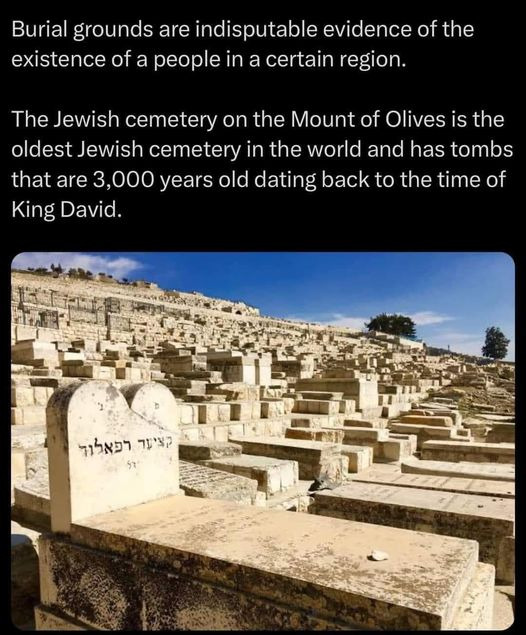
#MOUNT OF OLIVES#israel#secular-jew#jewish#judaism#israeli#jerusalem#diaspora#secular jew#secularjew#islam#INDIGENOUS#indigenous history#indigenous peoples#jewish indigeneity#indigeneity#historic#ancient roots#roots#proof of ancestry#proof of indigenousness#no ceasefire#hamas#palestinian
34 notes
·
View notes
Text
"prost and senna were so brutus/caesar coded" WRONG.
#call it the autism call it having a personal and deeply rooted interest in classics that permeates everything as a result but#the next time i see them compared to brutus and caesar because it's the only pairing that springs to mind i'll do heinous things#prost and senna. mark antony and cicero. caesar and pompey. their dynamic is diametrically opposed to so many in history#prosenna#alain prost#ayrton senna#formula 1#formula one#f1#classic f1#ancient history
33 notes
·
View notes
Note
One thing that I love about the greek representation and diversity in mythology debate is that... Yes, let's make it diverse! But only American diverse! Because poc who are actors only exist in the great USA of course!
"Oh, let's cast Athena as a black woman! A- a black woman born and raised in Greece? No, idiot, she was raised in Chicago and doesn't speak greek." Like why do these people even bring up the argument of race =/= ethnicity when they don't give a shit about ethnicity to begin with. If you want it to be racially diverse, at least cast poc raised in greece, or who descend from greeks but live in the US? Why is this diversity mindset only applied to the US? "Let's bring diversity to greek mythology by only employing non greek actors" do they even hear themselves?
They will get into a maze of arguments just to avoid saying their true opinion: that they think greeks are unable to represent their own culture, and that usa/british actors just play x god better. "The gods belong to all so fuck them greeks I guess."
Yeah, I get exactly what you're saying! It’s so weird how people bring up the whole race ≠ ethnicity thing but then completely ignore ethnicity when it actually matters. If they really cared about diversity in Greek mythology adaptations, they’d look at Greece’s *own* diversity instead of just slapping an American approach onto it. Like, Greece isn’t some isolated, monolithic place—there’s been cultural mixing for centuries—but that history doesn’t fit the simplified way Hollywood sees things.
What’s even more frustrating is how these conversations are always centered around the U.S., as if that’s the only place that defines what diversity even means. If they actually wanted an inclusive take, they’d at least cast actors who have a real connection to Greece, whether they are the locals ,they’re POC raised there or from the Greek diaspora. But instead, it’s just “diversity” that somehow erases Greek people entirely.
Again they fight the wrong people 😭 instead of sending hate online they should complain to the companies that make these projects in the first place.
#ask#greek representation#when it comes to greek gods i am most leaning how my ancestors portrayed them#that is pale mostly how the majority of ancient greeks were#but what about the other stories? the epics? that's rooted in greek culture?#the colour of the skin wasn't such a big deal like they make it now#life back then was complex#greek history is vast and rich#greek history
12 notes
·
View notes
Text

The oldest language in the world that is still spoken today is Greek, in second place is Chinese.
Greek is considered the oldest language in the world that is still spoken today, with a continuous history spanning over 3,400 years.
The Greek language has evolved significantly over the centuries, from Ancient Greek (the language of philosophers like Socrates and Plato) to Koine Greek (the language of the New Testament) and modern Modern Greek as spoken today.
Despite its changes over time, it maintains a deep connection to its ancient roots, especially in terms of vocabulary, structure, and influence on other languages.
In second place is Chinese, which is also one of the oldest and most enduring languages in the world.
The earliest form of written Chinese dates back over 3,000 years to Shang dynasty (around 1200 BC).
Like Greek, Chinese has undergone significant evolution, with Classical Chinese being the standard for much of China's history, followed by Mandarin, which is the most widely spoken variety today.
Both Greek and Chinese not only hold linguistic significance but have also profoundly influenced philosophy, literature, and culture throughout history.
© The Archaeologist
#oldest written languages#language#greek#chinese#ancient roots#ancient civilizations#ancient history#history#civilization#linguistics#aramaic#hebrew#tamil#persian
8 notes
·
View notes
Text
I hate the whole sodomy is a thing you do homosexuality is a thing you are saying because it not only encourages a simplistic understanding of the medicalisation of homosexuality but it encourages this before and after myth. Everyone before homosexuality is assumed to see sexuality in the exact same way which leads to people citing Ancient Greece when talking about 18th century English culture. People will assume how someone in the 18th century must have understood sexuality because they lived in the before period without ever doing even the most basic research into 18th century queer history. There isn’t a cheat sheet to queer history if you want to understand how sexuality was understood in a particular culture during in a particular period you have to do the research.
#people who have never read 18th century queer history love to assume my takes are too modern#but the reality is 18th century English queer history is a lot closer to current culture than a lot of people realise#it sounds modern because a lot of our modern culture has roots in 18th century culture#18th century England is closer to us than it is to Ancient Greece#queer history
70 notes
·
View notes
Text
Unveiling the Spellbinding Origins of Halloween Shaina Tranquilino October 30, 2023
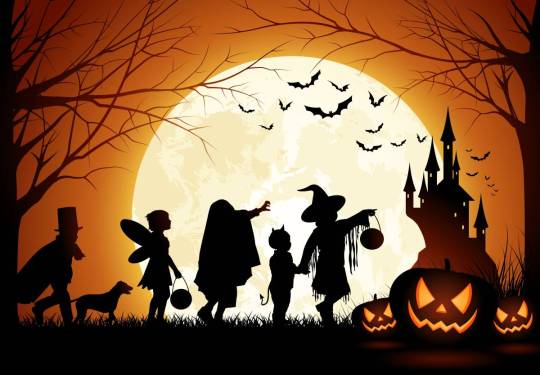
As orange leaves flutter to the ground and jack-o'-lanterns flicker in the night, it's undeniable that Halloween has become a beloved, spine-tingling celebration worldwide. But have you ever wondered about the bewitching origins hiding behind this enchanting holiday? Join us on a captivating journey as we unravel the mysterious history of Halloween.
Ancient Roots: The roots of Halloween can be traced back over 2,000 years to an ancient Celtic festival called Samhain (pronounced sow-in). Celebrated by the Celts in Ireland, Scotland, and parts of Britain, Samhain marked the end of summer and welcomed the harvest season. On October 31st, they believed that the boundary between the living and dead blurred, allowing spirits to roam freely among them.
Trick-or-Treating Takes Shape: During Samhain festivities, people would dress in costumes made from animal hides, attempting to ward off evil spirits or disguise themselves from mischievous entities. They also lit bonfires as a form of protection against malevolent forces—a tradition that still echoes today with our glowing Jack-o'-lanterns.
Christian Influence: In the 9th century A.D., Christianity began spreading throughout Celtic lands. Pope Gregory III designated November 1st as All Saints' Day or All Hallows' Day to honour saints and martyrs who didn't have their own feast day yet. To integrate pagan traditions into Christian practices and discourage Celtic rituals during Samhain, November 1st became known as All Hallows' Eve—the precursor to modern-day Halloween.
Ghostly Evolutions: As time progressed, various customs blended together to shape Halloween into its present form. In Medieval England, "souling" emerged when beggars went door-to-door offering prayers for departed souls in exchange for food or money—a practice that later inspired modern-day trick-or-treating. Similarly, in Scotland and Ireland, "guising" appeared, with people dressing up in costumes to perform songs, poems, or tricks for treats.
The Immigrant Influence: Halloween as we know it today found its way to North America through Irish and Scottish immigrants during the 19th century. In the United States, these traditions merged with Indigenous harvest celebrations and other European customs. The result was a uniquely "American Halloween"—a time of community gatherings, parties, parades, and spooky festivities that captured hearts across the nation.
Modern-Day Celebrations: In recent decades, Halloween has gained immense popularity worldwide. It has evolved into a holiday celebrated by people of all ages—both young and old. Festivities range from creatively carved pumpkins to haunted houses, costume parties to horror movie marathons—all embraced as part of this spirited celebration.
As darkness descends on All Hallows' Eve each year, we're reminded of the fascinating history behind Halloween's enduring magic. From ancient Celtic rituals to religious adaptations and cultural exchanges, this captivating holiday has grown into an enchanting blend of tradition and fun.
So whether you find yourself mesmerized by ghostly tales around a bonfire or joining the chorus of tiny witches and superheroes chanting "trick-or-treat," remember that Halloween is more than just costumes and candy—it's a bewitching journey through time connecting us to centuries-old customs and shared human experiences.
#Halloween#Halloween Origins#Halloween History#Samhain Traditions#Celtic Festivals#Pagan Roots#All Hallows Eve#Ancient Beliefs#Harvest Celebrations#October 31#October#Spooky season#Happy Halloween#Trick or Treat#jack o lantern#spooky#spooky time#hello october#autumm
21 notes
·
View notes
Text
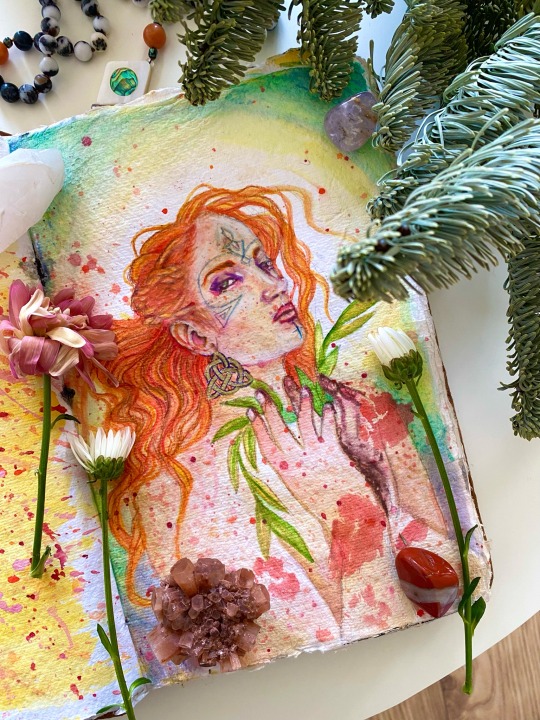
Astronomical Imbolc is the halfway point between the winter solstice and the spring equinox and occurs around the 4th/ 5th of February, but many people celebrate Imbol arriving on the eve of February the 1st and day of the 2nd on the Gregorian calendar. Only a couple years back did Ireland make St. Brigid Day, syncretized with pagan Imbolc, a national holiday to occur on the first Monday on February.
The actual identity of who founded St. Brigid’s monastery in Kildare, Ireland is unknown. To accept St. Brigid’s historical existence is a leap of faith since we have no hard evidence: no writings by St. Brigid or contemporaries, only a biography from over 150 years after her supposed death, circa 650ad.
The ancient Celtic goddess Brigid’s existence is no less a matter of faith by the same standards of written evidence. It was not until later in the 9th century that the Sanas Cormaic first documenting the divine feminine figure of Brigid was written by the King of Munster, also a Catholic bishop. This glossary admittedly collects memories of pre Christian times and describes three divine sisters each called Brigid with different occupations: poet, healer, smith. Quoting (translated) from this 1000+ year old source: “from whose names with all Irishmen a goddess was called Brigid” making Brigid seem as more a title than name. This is controversial among modern pagans whose leaps of faith insist Brigid as a “triple goddess” with one singular identity as “maiden, mother, crone” and rejecting the historical record of a sistership, either ignorant to or untrusting church records, understandably.
While it is easy to get caught up in the arguments about whether St. Brigid is an overlay upon the various pagan Brigids- and whether Brigid is a later incarnation of Danu or a variant of other spring goddesses- even within the various contradictory interpretations of who Brigid is- the remaining meaning is shared: the arrival of light and new life.
I got this vision of Brigid from some orange water color splatters across the page that reminded me of freckles. I saw her there beneath them. So I brought her out. Her mysteries captivate me.
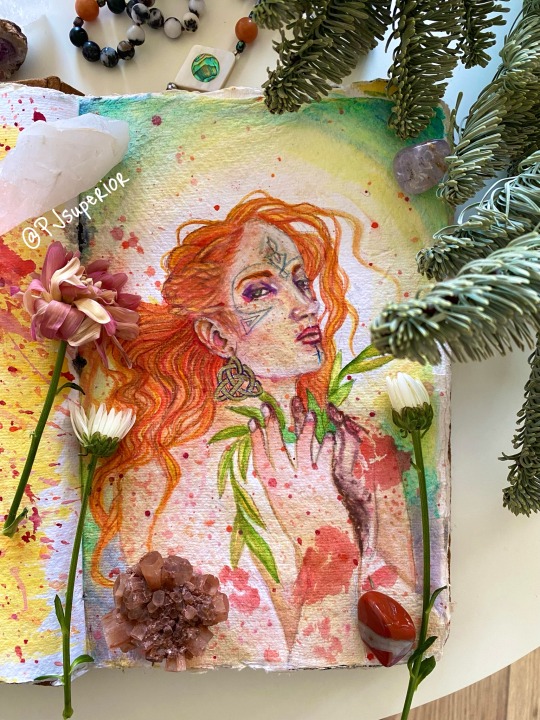
#Imbolc#st brigid#folk catholicism#goddess art#mother goddess#triple goddess#irish diaspora#watercolor#aquarelle#sketchbook#pagan artist#divine feminine#red hair#freckles#celtic#pagan roots#ancient history
2 notes
·
View notes
Text
logging back onto tumblr was like opening an ancient relic. coming back to my roots now that tiktok is getting shut down
4 notes
·
View notes
Video
youtube
Exploring Pizza's Delicious Journey Through Time
0 notes
Text
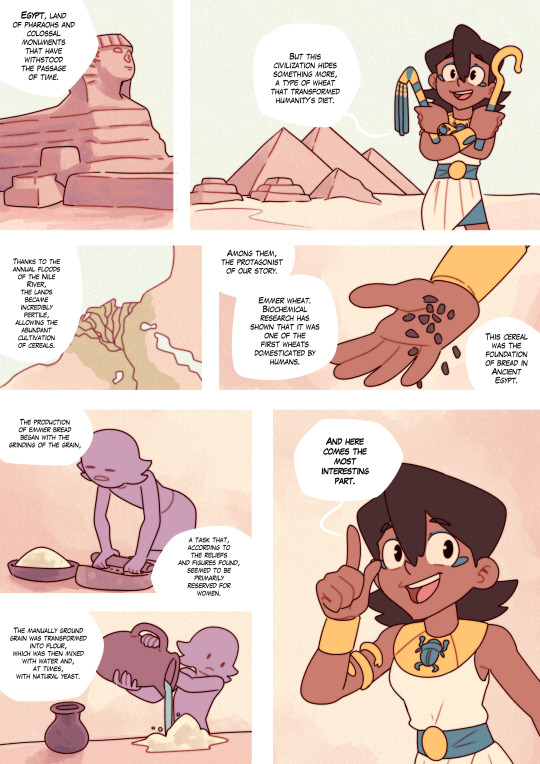

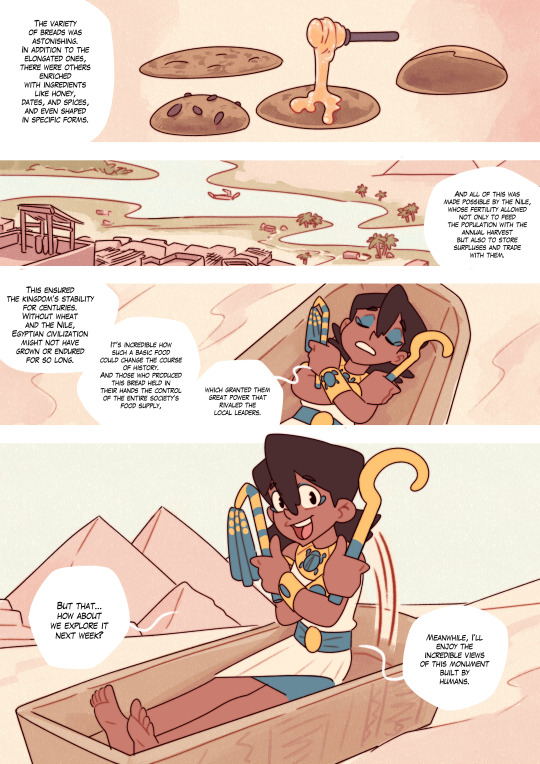
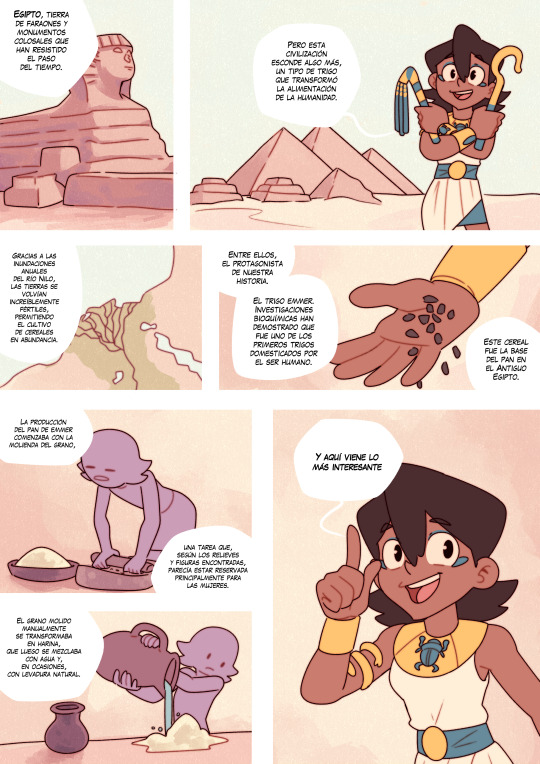
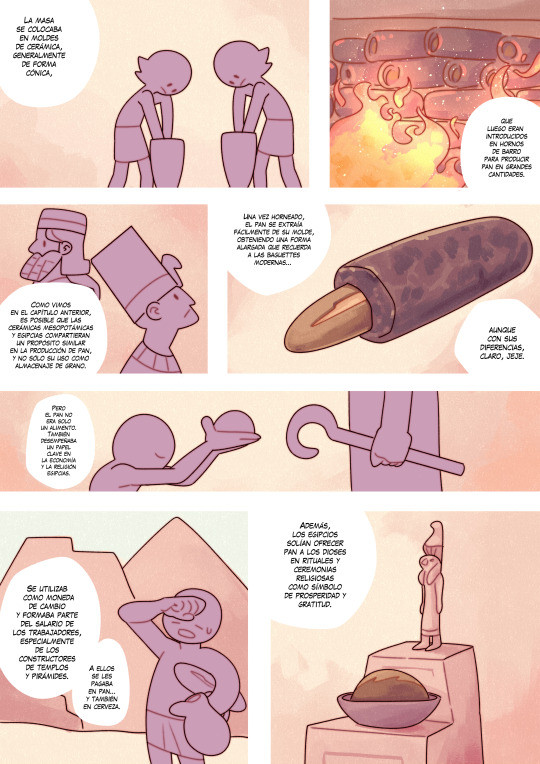
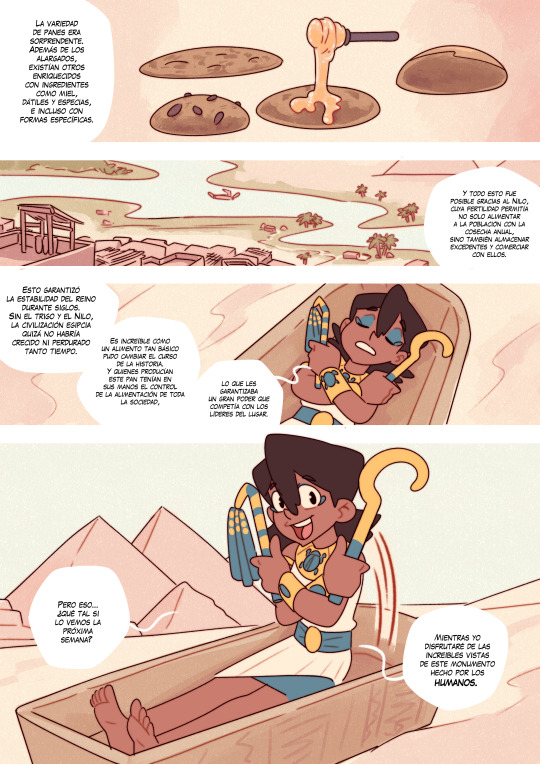
You can read all ROOTSSHORTS on my webcomic here: https://rootsshorts.neocities.org You can read both in english or ESPAÑOL with just a button
Also I had bluesky too: https://bsky.app/profile/manganart.bsky.social
#cartoon#cartoonstyle#manga#anime#comic#original character#character design#history#ancient egypt#egyptian#egyptology#culture#bread#roots shorts
5 notes
·
View notes
Text
How do you take a photo of time?

I've been watching the track events at the Olympics since I was a wee lad. It was a tradition in our family. We'd gather around our ancient low-definition 19 inch CRT television and watch tiny blobs compete against other tiny blobs and root for our country.
It was a bit like watching YouTube on your phone in 144p.
Several heroes emerged.
Jackie Joyner-Kersee was amazing.

You can't forget about Flo-Jo.

And then the Olympics decided NBA players were allowed in the competition.
Which formed... The Dream Team.
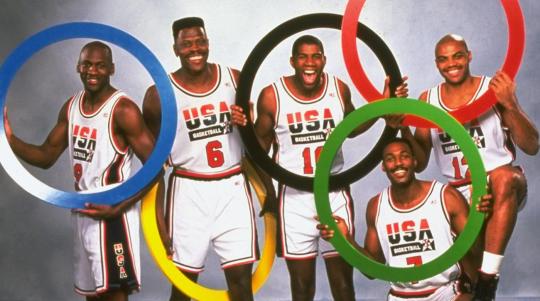
Was this fair?
Well... they won each game by an average of 44 points.
So... no. It was not fair.
Though it became more fair as time went on.
But, umm... yeah. The other teams looked like the Washington Generals and the US looked like the Harlem Globetrotters if they stopped screwing around half of the game.
But my absolute favorite Olympian was a runner named Michael Johnson.

He was cool as heck.
For one thing... gold shoes.

But he also had this crazy, upright, Tom Cruise-ish sprinting style that just made him look like a running robot on the track.

And in the 1996 Atlanta games he just trounced EVERYONE. I mean, it wasn't even close.

Yikes. Those losing blobs are probably really embarrassed.
Last night I decided to invigorate my nostalgia and watch the track events again. And I got to see one of the wildest races in history.
It didn't even last 10 seconds but it was one of the most exciting sporting events I've ever witnessed. Almost every runner won the race.
After I saw that initially, I was like... who the heck won???
Even in slow motion I wasn't sure.

This was one of the closest finishes in history. There has never been a race where all 8 runners were within this margin.
The arena was silent as the winner was being confirmed. The runners just kind of paced around waiting for official word. My best guess was the Jamaican runner, Kishane Thompson. But then the loudspeaker announced Noah Lyles.

The last tiny morsel of American pride burst out of me with a big "Wooooo!"
I forgot what it was like to be proud of my country. I wish it happened more often. But this young man, despite being last place in the first 3rd of the race, turned on the afterburners and won in a photo finish.
And that's when my inner nerd took over.
Because when they showed the photo finish image, it looked super weird.

Why is the track white?
Why do all of the runners look all warpy like that QWOP game?

So I went down a research rabbit hole to figure this out.
Photo finishes are actually fascinating. The first photo finish captured the end of a horse race in 1890. But that was mostly luck and timing. The actual photo finish mechanisms weren't used until 1937.
Originally they would film the finish line through a physical slit.

And the first horsie head that appeared in that slit would be the winner. This technology ended a huge aspect of corruption in horse race fixing almost overnight.
But we have come a long way since then. And I'd like to introduce you to the Omega Scan 'O' Vision Ultimate.

This slow motion camera sits fixed on the finish line of every race. The concept of the photo finish has remained remarkably similar to the 1930s approach. The camera sensor is specially designed to only record a vertical slit.
Only the finish line itself is actually captured.
And because it limits what it records to only that slit, it can capture 40,000 frames per second to get amazing temporal resolution.
So why don't the photo finishes just look like, well... this?

That is because the camera takes a picture of time more-so than dimensional space. I guess it would be more accurate to say it *assembles* a picture of time.
As the runners cross the finish line, the camera combines all of the little strips of pictures into a single image.






It's almost like if you tried to reassemble a piece of paper after it had been shredded.
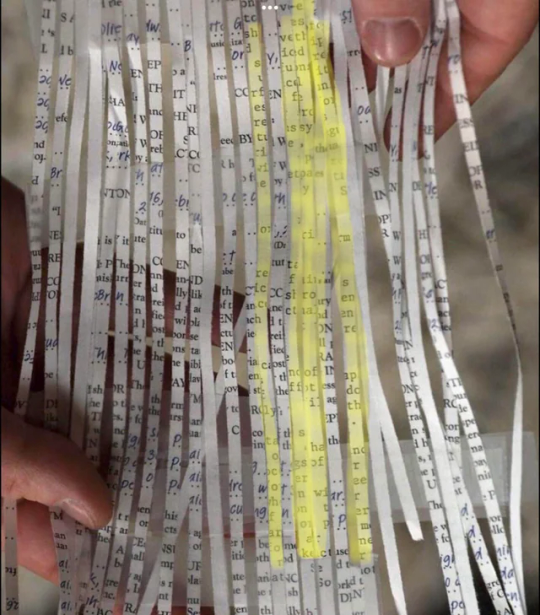
Imagine each strip of paper is a picture of ONLY the finish line, just at a slightly different point in time.
What if someone stopped on the finish line and didn't move... what would that look like?

Once they got there, the same part of their body would just be repeated.
So the right side of the photo finish picture represents earlier in time and it just assembles the image strip by strip as time passes and you literally get a picture of time itself.
NEAT!
Okay, but how do they determine the winner from the photo finish?
I mean, that shoe looks like it is ahead of Noah Lyles!
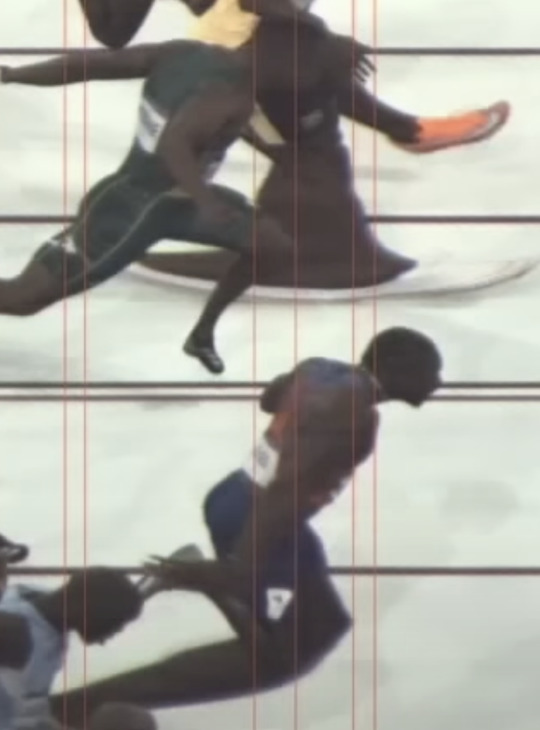
Clavicles!
The IAFF rules state the foremost part of the torso must cross the finish line first. And the endpoint of the torso is the outer end of the clavicle.
So if you get this bone across the finish line first, you win the race.

Two more fun facts!
The start of the race is actually just as carefully timed as the end of the race. There are sensors in the starting blocks of each runner.
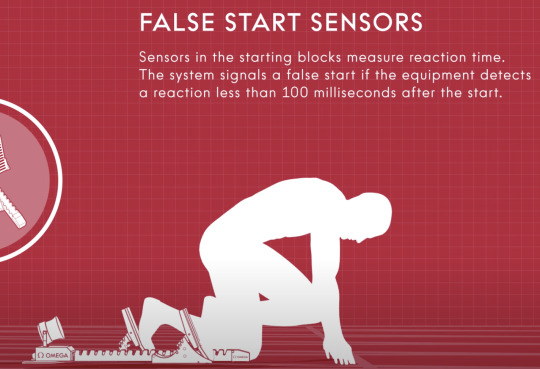
The starting gun also has an electronic sensor.

They have determined the fastest a human can react to the sound of a gun is roughly 100 milliseconds. So if you start running before 100 milliseconds they know you didn't actually hear the gun, you just got antsy and started running too early.
And the final fun fact...
Did you notice the Omega logo at the top of the photo finish?

That isn't superimposed or added after the fact. That is captured by the camera.
But if this image is composed only of tiny little slivers, how did they get the Omega logo to show up?

That is a little display. And it is synchronized with the Scan 'O' Vision Ultimate to show a little sliver of the Omega logo for each frame captured.

So when the final image is stitched together, it looks like a cohesive logo at the top of the photo.
Pretty clever, Omega!
26K notes
·
View notes
Text
Exploring the Beauty of Old English: 100 Words to Connect with the Past - Part 3
Old English unveils spiritual and cultural depth through words like hālig (holy) and sceadu (shadow). Their evolution bridges past wisdom with today, showing how language connects humanity across time.
Part 3 A Journey Through Words:Reflections on Old English Our journey into Old English has already taken us through diverse and fascinating aspects of the language in Parts 1 and Part 2, setting the stage for a deeper understanding of its richness and complexity. In this final installment, Part 3, we delve into the words that reflect the spiritual, the practical, and the abstract—the…
0 notes